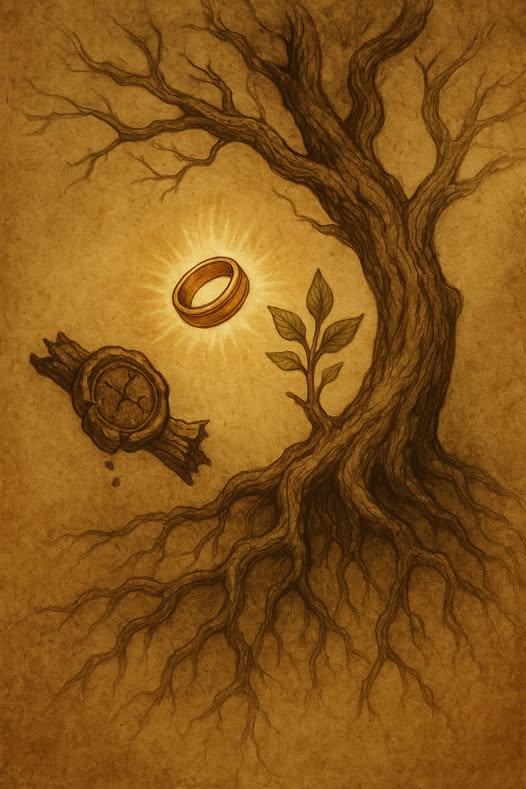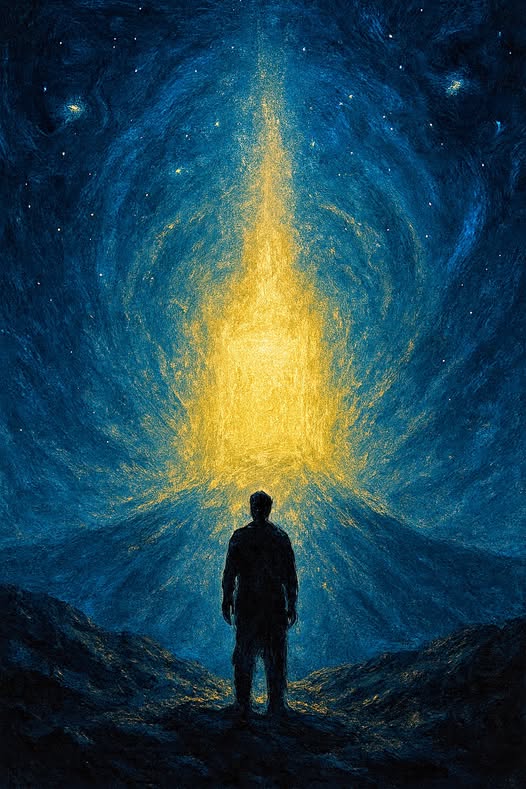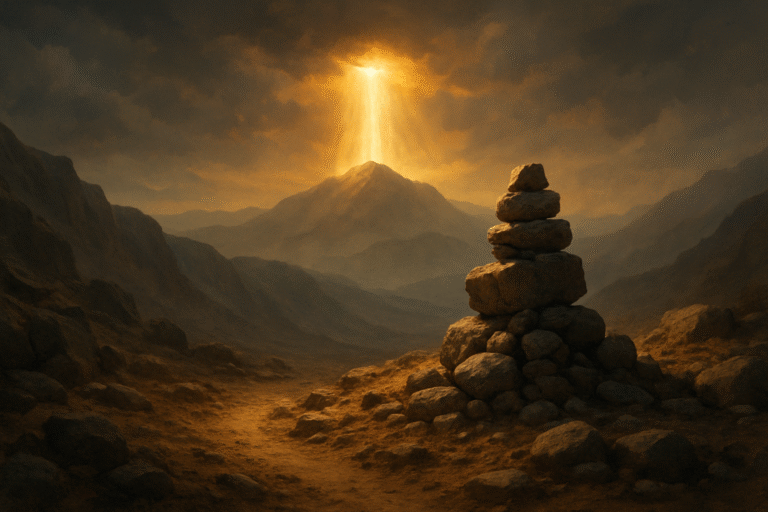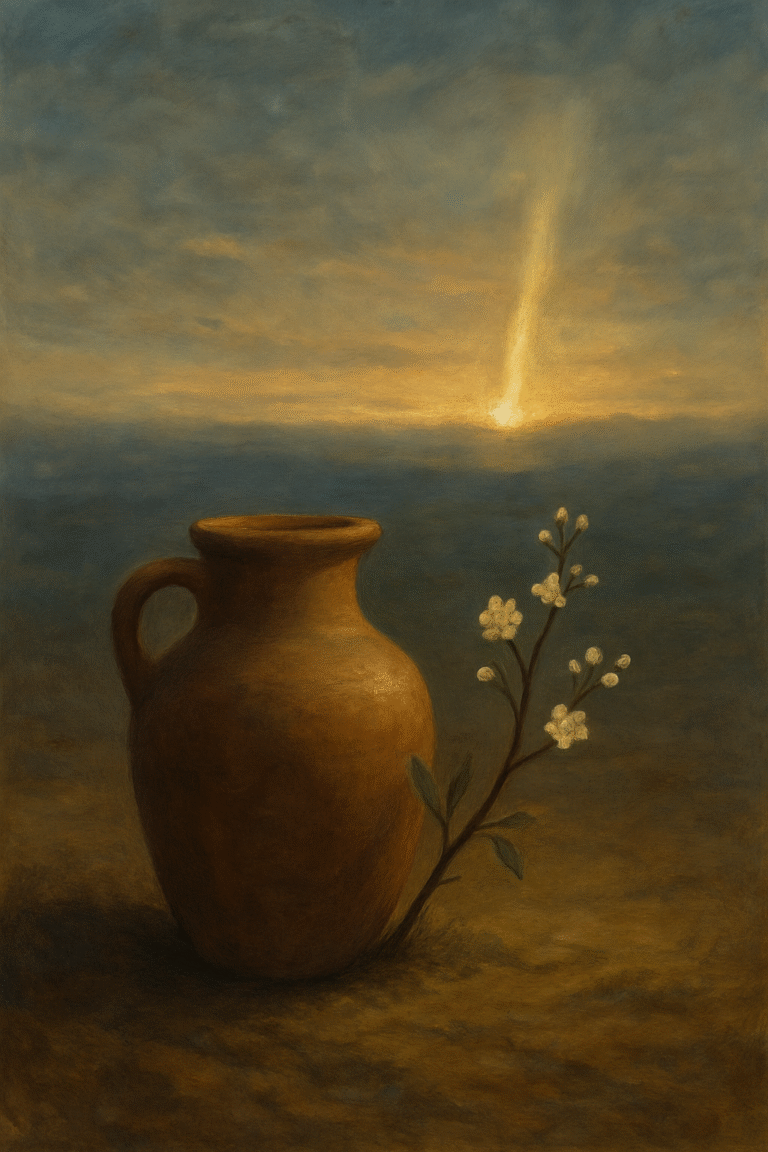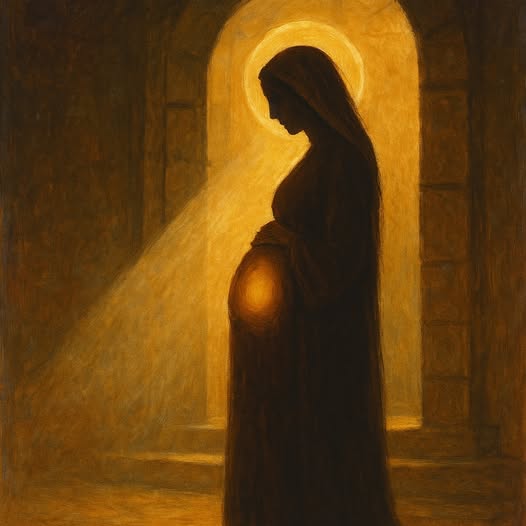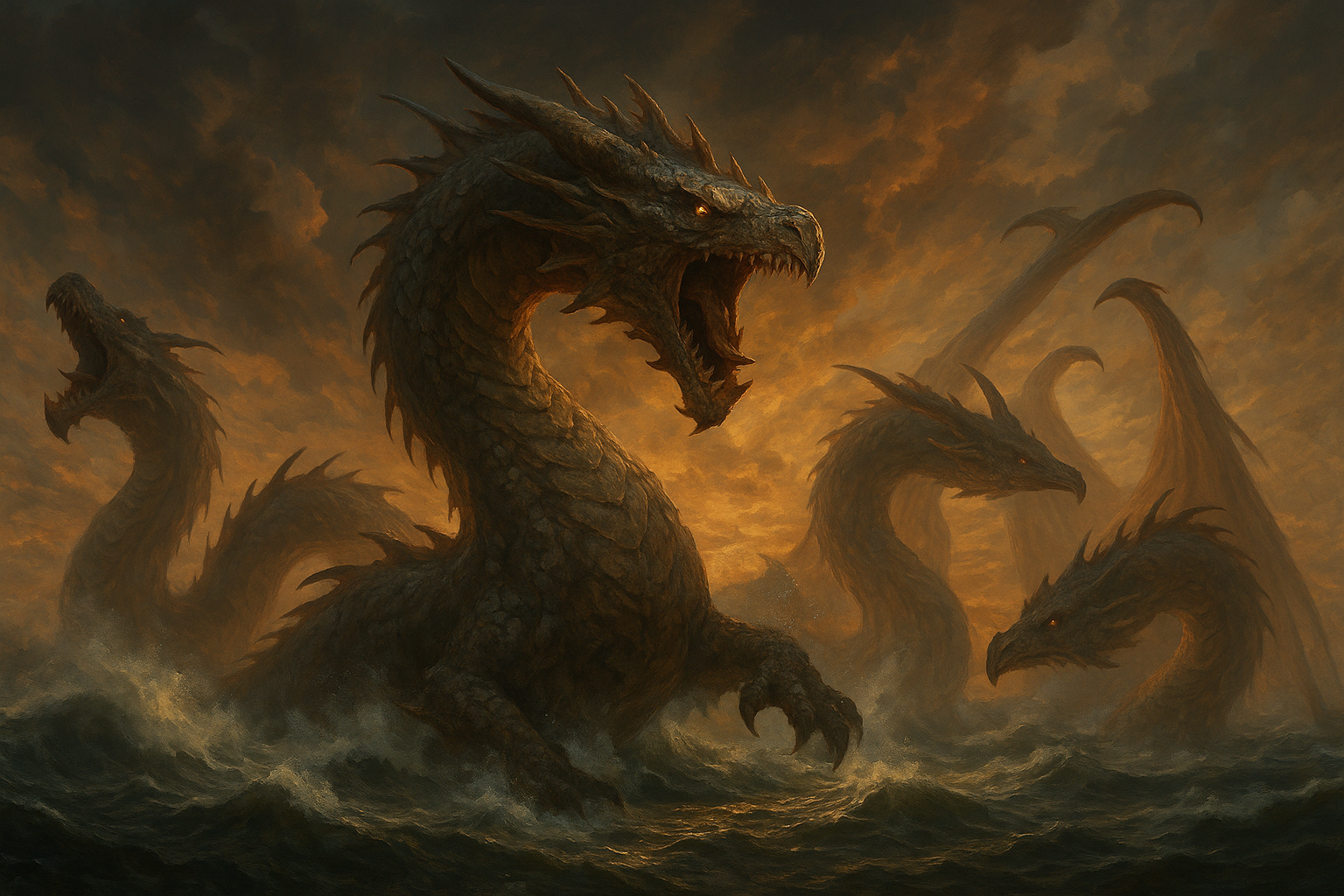
Dragons in the Ancient Near East were not the fire-breathing reptiles of fairy tales, but theological symbols of chaos and disorder. These creatures, often serpentine and bound to the sea, appeared in the myths of Mesopotamia, Canaan, and Egypt as primal threats to creation and order. They were not villains to be slain for sport, but forces that represented cosmic instability and opposition to divine rule. Yet the biblical authors did not merely adopt this imagery; they subverted it. The Bible engages with these traditions in a deliberate and pointed way, transforming the chaos monster into a stage upon which the unrivaled supremacy of Yahweh is made visible. Where the gods of the nations struggle against dragons, Yahweh speaks and they fall.
Tiamat and the Babylonian Birth of Order
In the Babylonian creation epic, the Enuma Elish, the primordial sea goddess Tiamat rises up after the murder of her consort Apsu. From her fury are born a host of monstrous beings, many of them hybrid or serpentine in form. Tiamat herself becomes a dragon-like embodiment of chaos, filled with venom, covered in scales, and breathing destruction. She is eventually defeated by the young god Marduk, who splits her in two and fashions the cosmos from her corpse. Heaven is formed from one half, earth from the other. Creation, in this narrative, is only possible through divine violence and conquest. Marduk earns his kingship not by decree, but by triumph in battle against the sea-dragon of old.
Lotan and the Storm-God of Canaan
A similar story unfolds in the Ugaritic texts of Canaan, where Baal Hadad, the storm-god, engages in combat with Lotan, a twisting seven-headed serpent who dwells in the sea. Lotan, a direct linguistic ancestor of the biblical Leviathan, is a creature of chaos whose defeat is necessary for Baal to establish his palace and reign. Without victory over Lotan, there is no divine order, no rain, no fertility, and no peace. Baal’s legitimacy hinges on his ability to conquer this cosmic threat.
Apophis and the Cycle of Cosmic Struggle
Egyptian mythology contributes to the pattern with Apophis, a colossal serpent who attempts to devour the sun god Ra as he journeys through the underworld each night. Though Ra triumphs daily, the victory is never permanent. Apophis returns each night, and the battle must be fought again. The Egyptian cosmos depends on vigilance, with order preserved only by repeated acts of resistance against encroaching chaos.
Myth as Memory, Not Fiction
Modern readers often hear the word “myth” and think of fantasy or fiction, but in the Ancient Near East, mythology was a legitimate and respected form of preserving meaning. These stories were not created to deceive or entertain, but to convey deep truths about the divine, the cosmos, and human existence. Myth served as a cultural memory device, a symbolic record of how people understood creation, order, and the battle between chaos and stability. The biblical authors did not reject this storytelling form but repurposed it. By using familiar imagery like sea monsters or cosmic battles, they engaged directly with the worldview of the surrounding nations. However, instead of affirming the theology of the pagans, they reoriented the narrative around the sovereignty of Yahweh. He does not struggle with chaos, He commands it. The dragons of the nations are not equal foes, they are His creations, crushed or contained at will. In this way, the Bible speaks into the mythic framework of its world and corrects it, declaring that behind the distorted memories of the nations stands the one true God, who alone rules heaven and earth.
The Biblical Polemic: Subverting the Myth
Into this shared mythological framework, the Bible speaks a counter-message. It does not deny the existence of dragons or chaos monsters. Instead, it reframes them to proclaim the sovereignty of Yahweh. Where Marduk must battle Tiamat to establish order, Yahweh simply speaks and the world is formed. Where Baal must struggle against Lotan, Yahweh mocks Leviathan as a creature formed for play. Where Ra must fight nightly to keep Apophis at bay, Yahweh tramples the sea and breaks Rahab with a word.
Leviathan, the most well-known biblical dragon, appears in several passages. In Job 41, he is described in terrifying detail—his impenetrable scales, his fearsome teeth, his fire-breathing nostrils. Yet this fearsome creature is presented not as a threat to God, but as a boast. “Can you draw out Leviathan with a hook?” God asks Job. The implication is that only God can tame or contain such a being. In Psalm 74, God is said to have crushed the heads of Leviathan, while Isaiah 27 foretells the final slaying of “Leviathan the fleeing serpent, Leviathan the twisting serpent, the dragon that is in the sea.” These texts use familiar ANE imagery, but their purpose is not to elevate Yahweh through conflict—it is to show that He was never threatened to begin with.
Rahab, another chaos figure, appears in Job 26 and Psalm 89, where God is praised for shattering her in the process of creating the world. Later, the name becomes associated with Egypt, drawing a link between the mythic enemy of order and a real political power that opposed Israel. The comparison is not accidental. The biblical authors are turning their enemies into symbols of cosmic rebellion, and then showing that God has already triumphed over them.
Perhaps the most striking turn comes in Psalm 104, where Leviathan is said to have been formed by God simply “to play” in the sea. The terrifying monster of myth is here reduced to a creature of divine amusement. It is a stunning reversal. The dragon that once stood in the way of creation now swims like a fish in a pond, made not for war but for wonder.
Creation Without Conflict
What makes the biblical use of dragon imagery so polemical is not just its familiarity, but its reversal. In the ANE, order must be wrested from chaos by strength. In the Bible, chaos is never independent. It is created, bounded, and sometimes destroyed, but always subordinate. Genesis 1 contains no dragon, no war, no battle. The deep exists, but it is dark and formless, not a malevolent entity. God speaks, and light is made. He separates the waters and assigns them boundaries. Creation is not a victory—it is a command.
This theological shift is profound. The Bible is not merely adopting the myths of its neighbors; it is correcting them. The monsters they feared are real, but not sovereign. Yahweh alone is sovereign. Where others see a world born from combat, the Bible shows a cosmos formed by divine will. Where other gods establish their rule through conquest, Yahweh rules because He is Creator.
The Dragon and the End of the Age
The imagery of the dragon reappears in Revelation, where the great red dragon is identified as Satan, the ancient serpent. He has seven heads and ten horns, echoing the chaos beasts of old. Yet his fate is sealed from the start. Cast down from heaven, defeated by Michael, bound in chains, and finally thrown into the lake of fire, the dragon is not an opponent God must struggle with, but an enemy already doomed. The end echoes the beginning—chaos is allowed to rise for a moment, only to be shattered once again.
Conclusion
The dragons of the Ancient Near East—Tiamat, Lotan, Apophis—were symbols of chaos, disorder, and rebellion. Their defeat was necessary for creation and kingship, and their stories shaped the mythologies of Mesopotamia, Canaan, and Egypt. The biblical authors were fully aware of these stories, and they did not avoid them. Instead, they repurposed them. In doing so, they made a theological claim far more radical than their neighbors: Yahweh does not earn His power by defeating dragons—He rules because He made them.
The biblical use of dragon imagery is not passive borrowing but deliberate polemic. The myths are not affirmed, they are answered. The chaos that others feared is not outside of God—it is under Him. Whether crushed, mocked, or merely ignored, the dragon in Scripture is never a threat. It is a reminder that there is no other god, no rival power, no battle for supremacy. There is only the Creator, and the creatures that tremble before Him.
Discussion Questions
- How does the Bible’s portrayal of Leviathan and Rahab serve as a critique of other ANE creation myths?
- Why is it significant that Genesis does not feature a battle narrative between God and a chaos creature?
- In what ways does the transformation of Leviathan into a playful sea creature in Psalm 104 undermine the mythic power attributed to dragons in surrounding cultures?
- How does the imagery of the dragon in Revelation connect with and diverge from earlier biblical and ANE traditions?
- What does the Bible’s polemic use of chaos monsters reveal about its understanding of divine sovereignty and the nature of creation?
Want to Know More?
- God at War: The Bible & Spiritual Conflict by Gregory A. Boyd
A theological overview of how ancient cosmic conflict imagery shapes the biblical worldview. Boyd gives special attention to the war motif in both Old and New Testaments. - The Unseen Realm: Recovering the Supernatural Worldview of the Bible by Michael S. Heiser
Heiser’s work highlights the divine council worldview and explores how biblical writers adapted ANE motifs, including dragons, to reveal spiritual truth. - Creation and Chaos in the Primeval Era and the Eschaton: A Religio-Historical Study of Genesis 1 and Revelation 12 by Hermann Gunkel
A foundational work tracing the theme of chaos and cosmic conflict from Genesis through Revelation. While older, it’s still cited for its role in identifying mythic structure within biblical texts. - Myths from Mesopotamia translated by Stephanie Dalley
A reliable collection of Mesopotamian myths, including the Enuma Elish, providing direct access to the source material involving Tiamat and other chaos creatures. - Ugaritic Narrative Poetry edited by Simon B. Parker
Essential reading for understanding Canaanite mythology, including Baal’s battle with Lotan and its influence on biblical imagery.

